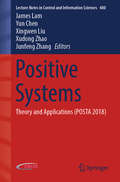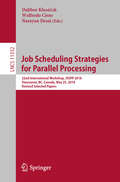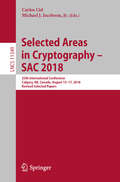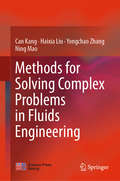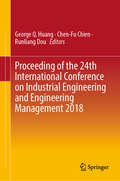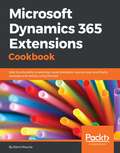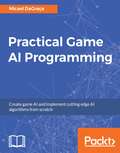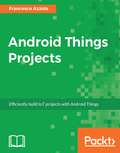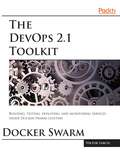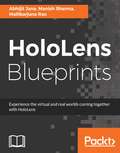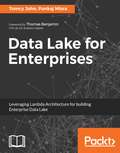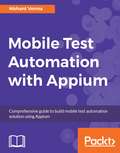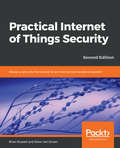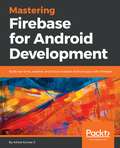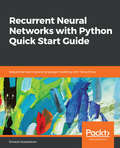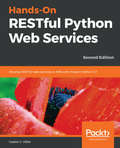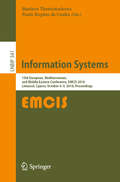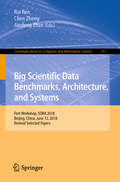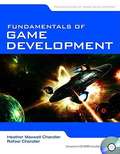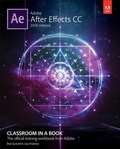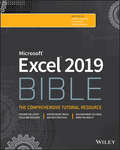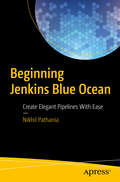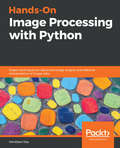- Table View
- List View
Positive Systems: Theory and Applications (POSTA 2018) (Lecture Notes in Control and Information Sciences #480)
by James Lam Yun Chen Xingwen Liu Xudong Zhao Junfeng ZhangThis book presents high-quality original contributions on positive systems, including those with positivity in compartmental switched systems, Markovian jump systems, Boolean networks, interval observer design, fault detection, and delay systems. It comprises a selection of the best papers from POSTA 2018, the 6th International Conference on Positive Systems, which was held in Hangzhou, China, in August 2018. The POSTA conference series represents a targeted response to the growing need for research that reports on and critically discusses a wide range of topics concerning the theory and applications of positive systems. The book offers valuable insights for researchers in applied mathematics, control theory and their applications.
Job Scheduling Strategies for Parallel Processing: 22nd International Workshop, JSSPP 2018, Vancouver, BC, Canada, May 25, 2018, Revised Selected Papers (Lecture Notes in Computer Science #11332)
by Dalibor Klusáček Walfredo Cirne Narayan DesaiThis book constitutes the thoroughly refereed post-conference proceedings of the 22nd International Workshop on Job Scheduling Strategies for Parallel Processing, JSSPP 2018, held in Vancouver, Canada, in May 2018.The 7 revised full papers presented were carefully reviewed and selected from12 submissions. The papers cover topics in the fields of design and evaluation of new scheduling approaches. They focus on several interesting problems in resource management and scheduling.
Selected Areas in Cryptography – SAC 2018: 25th International Conference, Calgary, AB, Canada, August 15–17, 2018, Revised Selected Papers (Lecture Notes in Computer Science #11349)
by Carlos Cid Michael J. Jacobson Jr.This book contains revised selected papers from the 25th International Conference on Selected Areas in Cryptography, SAC 2018, held in Calgary, AB, Canada in August 2018. The 22 full papers presented in this volume were carefully reviewed and selected from 57 submissions. They cover the following research areas:design and analysis of symmetric key primitives and cryptosystems, including block and stream ciphers, hash functions, MAC algorithms, and authenticated encryption schemesefficient implementations of symmetric and public key algorithmsmathematical and algorithmic aspects of applied cryptologycryptography for the Internet of Things
Methods for Solving Complex Problems in Fluids Engineering
by Can Kang Haixia Liu Yongchao Zhang Ning MaoThis book describes recently developed research methods used to study complex problems in fluid engineering, especially optical flow measurement, flow visualization and numerical methods. It includes a wealth of diagrams and images, and the content is presented in a step-by-step manner from beginning to end, helping readers grasp the central points of the book.The book also presents a number of practical cases, illustrating how the research methods covered can be concretely implemented. Lastly, the book offers a valuable point of departure for pursuing further research.
Proceeding of the 24th International Conference on Industrial Engineering and Engineering Management 2018
by George Q. Huang Chen-Fu Chien Runliang DouThis book records the new research findings and development in the field of industrial engineering, and it will serve as the guidebook for the potential development in industrial engineering and smart manufacturing. It gathers the accepted papers from the 24th International conference on Industrial Engineering and Engineering Management held at Central South University of Forestry and Technology in Changsha during May 19-20, 2018. The aim of this conference was to provide a high-level international forum for experts, scholars and entrepreneurs at home and abroad to present the recent advances, new techniques and application, to promote discussion and interaction among academics, researchers and professionals to promote the developments and applications of the related theories and technologies in universities and enterprises, and to establish business or research relations to find global partners for future collaboration in the field of Industrial Engineering. It addresses diverse themes in smart manufacturing, artificial intelligence, ergonomics, simulation and modeling, quality and reliability, logistics engineering, data mining and other related fields. This timely book summarizes and promotes the latest achievements in the field of industrial engineering and related fields over the past year, proposing prospects and vision for the further development.
Microsoft Dynamics 365 Extensions Cookbook
by Rami MounlaMore than 80 recipes to help you leverage the various extensibility features available for Microsoft Dynamics and solve problems easily About This Book • Customize, configure, and extend the vanilla features of Dynamics 365 to deliver bespoke CRM solutions fit for any organization • Implement business logic using point-and-click configuration, plugins, and client-side scripts with MS Dynamics 365 • Built a DevOps pipeline as well as Integrate Dynamics 365 with Azure and other platforms Who This Book Is For This book is for developers, administrators, consultants, and power users who want to learn about best practices when extending Dynamics 365 for enterprises. You are expected to have a basic understand of the Dynamics CRM/365 platform. What You Will Learn • Customize, configure, and extend Microsoft Dynamics 365 • Create business process automation • Develop client-side extensions to add features to the Dynamics 365 user interface • Set up a security model to securely manage data with Dynamics 365 • Develop and deploy clean code plugins to implement a wide range of custom behaviors • Use third-party applications, tools, and patterns to integrate Dynamics 365 with other platforms • Integrate with Azure, Java, SSIS, PowerBI, and Octopus Deploy • Build an end-to-end DevOps pipeline for Dynamics 365 In Detail Microsoft Dynamics 365 is a powerful tool. It has many unique features that empower organisations to bridge common business challenges and technology pitfalls that would usually hinder the adoption of a CRM solution. This book sets out to enable you to harness the power of Dynamics 365 and cater to your unique circumstances. We start this book with a no-code configuration chapter and explain the schema, fields, and forms modeling techniques. We then move on to server-side and client-side custom code extensions. Next, you will see how best to integrate Dynamics 365 in a DevOps pipeline to package and deploy your extensions to the various SDLC environments. This book also covers modern libraries and integration patterns that can be used with Dynamics 365 (Angular, 3 tiers, and many others). Finally, we end by highlighting some of the powerful extensions available. Throughout we explain a range of design patterns and techniques that can be used to enhance your code quality; the aim is that you will learn to write enterprise-scale quality code. Style and approach This book takes a recipe-based approach, delivering practical examples and use cases so that you can identify the best possible approach to extend your Dynamics 365 deployment and tackle your specific business problems.
Practical Game AI Programming
by Micael DagracaJump into the world of Game AI development About This Book • Move beyond using libraries to create smart game AI, and create your own AI projects from scratch • Implement the latest algorithms for AI development and in-game interaction • Customize your existing game AI and make it better and more efficient to improve your overall game performance Who This Book Is For This book is for game developers with a basic knowledge of game development techniques and some basic programming techniques in C# or C++. What You Will Learn • Get to know the basics of how to create different AI for different type of games • Know what to do when something interferes with the AI choices and how the AI should behave if that happens • Plan the interaction between the AI character and the environment using Smart Zones or Triggering Events • Use animations correctly, blending one animation into another and rather than stopping one animation and starting another • Calculate the best options for the AI to move using Pruning Strategies, Wall Distances, Map Preprocess Implementation, and Forced Neighbours • Create Theta algorithms to the AI to find short and realistic looking paths • Add many characters into the same scene and make them behave like a realistic crowd In Detail The book starts with the basics examples of AI for different game genres and directly jumps into defining the probabilities and possibilities of the AI character to determine character movement. Next, you'll learn how AI characters should behave within the environment created. Moving on, you'll explore how to work with animations. You'll also plan and create pruning strategies, and create Theta algorithms to find short and realistic looking game paths. Next, you'll learn how the AI should behave when there is a lot of characters in the same scene. You'll explore which methods and algorithms, such as possibility maps, Forward Chaining Plan, Rete Algorithm, Pruning Strategies, Wall Distances, and Map Preprocess Implementation should be used on different occasions. You'll discover how to overcome some limitations, and how to deliver a better experience to the player. By the end of the book, you think differently about AI. Style and approach The book has a step-by-step tutorial style approach. The algorithms are explained by implementing them in #.
Android Things Projects
by Francesco AzzolaDevelop smart Internet of things projects using Android Things. About This Book • Learn to build promising IoT projects with Android Things • Make the most out of hardware peripherals using standard Android APIs • Build enticing projects on IoT, home automation, and robotics by leveraging Raspberry Pi 3 and Intel Edison Who This Book Is For This book is for Android enthusiasts, hobbyists, IoT experts, and Android developers who want to gain a deeper knowledge of Android Things. The main focus is on implementing IoT projects using Android Things. What You Will Learn • Understand IoT ecosystem and the Android Things role • See the Android Things framework: installation, environment, SDK, and APIs • See how to effectively use sensors (GPIO and I2C Bus) • Integrate Android Things with IoT cloud platforms • Create practical IoT projects using Android Things • Integrate Android Things with other systems using standard IoT protocols • Use Android Things in IoT projects In Detail Android Things makes developing connected embedded devices easy by providing the same Android development tools, best-in-class Android framework, and Google APIs that make developers successful on mobile. With this book, you will be able to take advantage of the new Android framework APIs to securely build projects using low-level components such as sensors, resistors, capacitors, and display controllers. This book will teach you all you need to know about working with Android Things through practical projects based on home automation, robotics, IoT, and so on. We'll teach you to make the most of the Android Things and build enticing projects such as a smart greenhouse that controls the climate and environment automatically. You'll also create an alarm system, integrate Android Things with IoT cloud platforms, and more. By the end of this book, you will know everything about Android Things, and you'll have built some very cool projects using the latest technology that is driving the adoption of IoT. You will also have primed your mindset so that you can use your knowledge for profitable, practical projects. Style and approach This book is packed with fun-filled, end-to-end projects that you will be encouraged to experiment on the Android Things OS.
The DevOps 2.1 Toolkit: Docker Swarm
by Viktor FarcicViktor Farcic's latest book, The DevOps 2.1 Toolkit: Docker Swarm, shows you how to successfully integrate Docker Swarm into your DevOps toolset. About This Book • Expand your DevOps Toolkit with the DevOps thought leader, Viktor Farcic • Build, test, deploy, and monitor services inside Docker Swarm clusters • Translate your understanding to different hosting providers like AWS, Azure, and DigitalOcean • Go beyond simple deployment to explore how to create a continuous deployment process • Extend the deep understanding you gained from Viktor's DevOps 2.0 Toolkit book Who This Book Is For This book is for professionals interested in the full microservices life cycle combined with continuous deployment and containers. Target audience could be architects who want to know how to design their systems around microservices. It could be DevOps wanting to know how to apply modern configuration management practices and continuously deploy applications packed in containers. It is for developers who would like to take the process back into their hands as well as for managers who would like to gain a better understanding of the process used to deliver software from the beginning to the end. This book is for everyone wanting to know more about the software development life cycle starting from requirements and design, through the development and testing all the way until deployment and post-deployment phases. We'll create the processes taking into account the best practices developed by and for some of the biggest companies. What You Will Learn • Learn all aspects of Docker Swarm from building, testing, deploying, and monitoring services inside Docker Swarm clusters, available since Docker 1.12. • Master the deeper logic of DevOps with Viktor, so that you can successfully apply that logic across any specific set of tools you're working with. • Translate a deep understanding to different hosting providers like AWS, Azure, DigitalOcean, among others. • You'll go beyond simple deployment: you will explore with Viktor how to create a continuous deployment process. Accomplish zero-downtime deployments, and what to do in case of a failover. • Know how to run services at scale, how to monitor the systems, and how to make it heal itself. In Detail Viktor Farcic's latest book, The DevOps 2.1 Toolkit: Docker Swarm, takes you deeper into one of the major subjects of his international best seller, The DevOps 2.0 Toolkit, and shows you how to successfully integrate Docker Swarm into your DevOps toolset. Viktor shares with you his expert knowledge in all aspects of building, testing, deploying, and monitoring services inside Docker Swarm clusters. You'll go through all the tools required for running a cluster. You'll travel through the whole process with clusters running locally on a laptop. Once you're confident with that outcome, Viktor shows you how to translate your experience to different hosting providers like AWS, Azure, and DigitalOcean. Viktor has updated his DevOps 2.0 framework in this book to use the latest and greatest features and techniques introduced in Docker. We'll go through many practices and even more tools. While there will be a lot of theory, this is a hands-on book. You won't be able to complete it by reading it on the metro on your way to work. You'll have to read this book while in front of the computer and get your hands dirty. Style and approach We'll go through many practices and even more tools. While there will be a lot of theory, this is a hands-on book. You'll have to read this book while in front of the computer and get your hands dirty. The goal is not to master one particular set of tools, but to learn the logic behind them so that you can apply it to your job in various contexts.
HoloLens Blueprints
by Abhijit Jana Mallikarjuna Rao Manish SharmaUnveil the world of mixed reality with HoloLens About This Book • Bring holographic insights to existing line-of-business applications, tools, and workflows • Focus on developing end-to-end realistic holographic application. • Build interactive model scripts and test them in Unity3D and holographic emulators Who This Book Is For This book is targeted at developers and designers working on mixed-reality developments for complex integrated scenarios using HoloLens. What You Will Learn • Interact with holograms using different interaction models • Develop your first holographic app • Integrate holographic applications with cloud systems • Visualize data feeds coming from the cloud through holograms • Manage the application distribution of enterprise-enabled HoloLens • Integrate HoloLens applications with services deployed on Azure • Identify and create 3D Assets and Scenes • Use HoloLens to explore the Internet of Things In Detail Do you want to create stunning applications with HoloLens? Are you a developer who is fascinated with Microsoft HoloLens and its capabilities? If so, this is the book for you. This book introduces and demystifies the HoloLens platform and shows you different ways of interaction with computers (mixed-reality). You will start your mixed-reality journey by understanding different types of digital reality. You will learn to build your first holographic app. Also, you will understand holographic application integration possibilities within Line of Business Applications using Azure. Moving ahead, you will create Integrated Solutions using IoT with HoloLens. Gradually you'll learn how to create and deploy apps on a device. You will learn to publish application to the store; if you are an enterprise developer, you will also manage and distribute applications for enterprise-enabled or domain-joined HoloLens. Finally, you will develop an end-to-end realistic holographic app, ranging from scenario identification to sketching, development, deployment, and, finally, production. Style and approach The book is a project-based guide to help you to create some really astonishing mixed-reality applications. It will provide end-to-end solutions and enable you to build stunning applications for HoloLens.
Data Lake for Enterprises
by Tomcy John Pankaj MisraA practical guide to implementing your enterprise data lake using Lambda Architecture as the base About This Book • Build a full-fledged data lake for your organization with popular big data technologies using the Lambda architecture as the base • Delve into the big data technologies required to meet modern day business strategies • A highly practical guide to implementing enterprise data lakes with lots of examples and real-world use-cases Who This Book Is For Java developers and architects who would like to implement a data lake for their enterprise will find this book useful. If you want to get hands-on experience with the Lambda Architecture and big data technologies by implementing a practical solution using these technologies, this book will also help you. What You Will Learn • Build an enterprise-level data lake using the relevant big data technologies • Understand the core of the Lambda architecture and how to apply it in an enterprise • Learn the technical details around Sqoop and its functionalities • Integrate Kafka with Hadoop components to acquire enterprise data • Use flume with streaming technologies for stream-based processing • Understand stream- based processing with reference to Apache Spark Streaming • Incorporate Hadoop components and know the advantages they provide for enterprise data lakes • Build fast, streaming, and high-performance applications using ElasticSearch • Make your data ingestion process consistent across various data formats with configurability • Process your data to derive intelligence using machine learning algorithms In Detail The term "Data Lake" has recently emerged as a prominent term in the big data industry. Data scientists can make use of it in deriving meaningful insights that can be used by businesses to redefine or transform the way they operate. Lambda architecture is also emerging as one of the very eminent patterns in the big data landscape, as it not only helps to derive useful information from historical data but also correlates real-time data to enable business to take critical decisions. This book tries to bring these two important aspects — data lake and lambda architecture—together. This book is divided into three main sections. The first introduces you to the concept of data lakes, the importance of data lakes in enterprises, and getting you up-to-speed with the Lambda architecture. The second section delves into the principal components of building a data lake using the Lambda architecture. It introduces you to popular big data technologies such as Apache Hadoop, Spark, Sqoop, Flume, and ElasticSearch. The third section is a highly practical demonstration of putting it all together, and shows you how an enterprise data lake can be implemented, along with several real-world use-cases. It also shows you how other peripheral components can be added to the lake to make it more efficient. By the end of this book, you will be able to choose the right big data technologies using the lambda architectural patterns to build your enterprise data lake. Style and approach The book takes a pragmatic approach, showing ways to leverage big data technologies and lambda architecture to build an enterprise-level data lake.
Mobile Test Automation with Appium
by Nishant VermaAutomate your mobile app testing About This Book • How to automate testing with Appium • Apply techniques for creating comprehensive tests • How to test on physical devices or emulators Who This Book Is For Are you a mobile developer or a software tester who wishes to use Appium for your test automation? If so, then this is the right book for you .You must have basic Java programming knowledge. You don't need to have prior knowledge of Appium. What You Will Learn • Discover Appium and how to set up an automation framework for mobile testing • Understand desired capabilities and learn to find element locators • Learn to automate gestures and synchronize tests using Appium • Take an incremental approach to implement page object pattern • Learn to run Appium tests on emulators or physical devices • Set up Jenkins to run mobile automation tests by easy to learn steps • Discover tips and tricks to record video of test execution, inter app automation concepts • Learn to run Appium tests in parallel on multiple devices simultaneously In Detail Appium is an open source test automation framework for mobile applications. It allows you to test all three types of mobile applications: native, hybrid, and mobile web. It allows you to run the automated tests on actual devices, emulators, and simulators. Today, when every mobile app is made on at least two platforms, iOS and Android, you need a tool that allows you to test across platforms. Having two different frameworks for the same app increases the cost of the product and time to maintain it as well. Appium helps save this cost. With mobile app growth exploding, mobile app automation is mainstream now. In this book, author Nishant Verma provides you with a firm grounding in the concepts of Appium while diving into how to set up appium & Cucumber-jvm test automation framework, implement page object design pattern, automate gestures, test execution on emulators and physical devices, and implement continuous integration with Jenkins. The mobile app we have referenced in this book is Quikr because of its relatively lower learning curve to understand the application. It's a local classifieds shopping app. Style and approach This book takes a practical, step-by-step approach to testing and automating individual apps such as native, hybrid, and mobile web apps using different examples.
Practical Internet of Things Security: Design a security framework for an Internet connected ecosystem, 2nd Edition
by Brian Russell Drew Van DurenA practical, indispensable security guide that will navigate you through the complex realm of securely building and deploying systems in our IoT-connected worldKey FeaturesLearn best practices to secure your data from the device to the cloudUse systems security engineering and privacy-by-design principles to design a secure IoT ecosystemA practical guide that will help you design and implement cyber security strategies for your organizationBook DescriptionWith the advent of the Internet of Things (IoT), businesses have to defend against new types of threat. The business ecosystem now includes the cloud computing infrastructure, mobile and fixed endpoints that open up new attack surfaces. It therefore becomes critical to ensure that cybersecurity threats are contained to a minimum when implementing new IoT services and solutions.This book shows you how to implement cybersecurity solutions, IoT design best practices, and risk mitigation methodologies to address device and infrastructure threats to IoT solutions.In this second edition, you will go through some typical and unique vulnerabilities seen within various layers of the IoT technology stack and also learn new ways in which IT and physical threats interact. You will then explore the different engineering approaches a developer/manufacturer might take to securely design and deploy IoT devices. Furthermore, you will securely develop your own custom additions for an enterprise IoT implementation. You will also be provided with actionable guidance through setting up a cryptographic infrastructure for your IoT implementations. You will then be guided on the selection and configuration of Identity and Access Management solutions for an IoT implementation. In conclusion, you will explore cloud security architectures and security best practices for operating and managing cross-organizational, multi-domain IoT deployments.What you will learnDiscuss the need for separate security requirements and apply security engineering principles on IoT devicesMaster the operational aspects of planning, deploying, managing, monitoring, and detecting the remediation and disposal of IoT systemsUse Blockchain solutions for IoT authenticity and integrityExplore additional privacy features emerging in the IoT industry, such as anonymity, tracking issues, and countermeasuresDesign a fog computing architecture to support IoT edge analyticsDetect and respond to IoT security incidents and compromisesWho this book is forThis book targets IT Security Professionals and Security Engineers (including pentesters, security architects and ethical hackers) who would like to ensure the security of their organization's data when connected through the IoT. Business analysts and managers will also find this book useful.
Mastering Firebase for Android Development: Build real-time, scalable, and cloud-enabled Android apps with Firebase
by Ashok Kumar SDevelop a fully functional and dynamic Android application using the latest features of FirebaseKey FeaturesExplore all the latest tools in Firebase—Firebase Firestore, ML-Kit, and Firebase PredictionsMaster Firebase cloud messaging, remote configuration, and work with a real-time databaseMake your app a global success with the help of Google Analytics and AdMobBook DescriptionFirebase offers a wide spectrum of tools and services to help you develop high-quality apps in a short period of time. It also allows you to build web and mobile apps quickly without managing the infrastructure.Mastering Firebase for Android Development takes you through the complete toolchain of Firebase,including the latest tools announced in Google IO 2018 such as Firebase ML-Kit, FireStore, and Firebase Predictions.The book begins by teaching you to configure your development environment with Firebase and set up a different structure for a Firebase real-time database. As you make your way through the chapters, you’ll establish the authentication feature in Android and explore email and phone authentication for managing the on-boarding of users. You’ll be taken through topics on Firebase crash reporting, Firebase functions, Firebase Cloud, Firebase Hosting, and Cloud Messaging for push notifications and explore other key areas in depth. In the concluding chapters, you will learn to use Firebase Test Lab to test your application before using Firebase Performance Monitoring to trace performance setbacks.By the end of the book, you will be well equipped with the Firebase ecosystem, which will help you find solutions to your common application development challenges.What you will learnLearn about Firebase push notifications and write backend functionalitiesIdentify the root cause of an application crash and diagnose and fix bugsStore different Multipurpose Internet MailExtension(MIME) type filesExplore web hosting and connect the Firebase functions to the host websiteSend push notifications and understand the deep integration of analytics tools and cohortsMarket and monetize your application using Firebase Adwords and AdmobBuild a secure authentication framework while enhancing the sign-in and on-boarding experience for end usersWho this book is forMastering Firebase for Android Development is for individualslooking to extend their skills with Firebase and build faster, scalable, and real-time mobile applications. Basic understanding of Android programming is necessary. In all, this in-depth guide is an accessible pathway to mastering Firebase.
Recurrent Neural Networks with Python Quick Start Guide: Sequential learning and language modeling with TensorFlow
by Simeon KostadinovLearn how to develop intelligent applications with sequential learning and apply modern methods for language modeling with neural network architectures for deep learning with Python's most popular TensorFlow framework. Key FeaturesTrain and deploy Recurrent Neural Networks using the popular TensorFlow libraryApply long short-term memory unitsExpand your skills in complex neural network and deep learning topicsBook DescriptionDevelopers struggle to find an easy-to-follow learning resource for implementing Recurrent Neural Network (RNN) models. RNNs are the state-of-the-art model in deep learning for dealing with sequential data. From language translation to generating captions for an image, RNNs are used to continuously improve results. This book will teach you the fundamentals of RNNs, with example applications in Python and the TensorFlow library. The examples are accompanied by the right combination of theoretical knowledge and real-world implementations of concepts to build a solid foundation of neural network modeling.Your journey starts with the simplest RNN model, where you can grasp the fundamentals. The book then builds on this by proposing more advanced and complex algorithms. We use them to explain how a typical state-of-the-art RNN model works. From generating text to building a language translator, we show how some of today's most powerful AI applications work under the hood.After reading the book, you will be confident with the fundamentals of RNNs, and be ready to pursue further study, along with developing skills in this exciting field.What you will learnUse TensorFlow to build RNN modelsUse the correct RNN architecture for a particular machine learning taskCollect and clear the training data for your modelsUse the correct Python libraries for any task during the building phase of your modelOptimize your model for higher accuracyIdentify the differences between multiple models and how you can substitute themLearn the core deep learning fundamentals applicable to any machine learning modelWho this book is forThis book is for Machine Learning engineers and data scientists who want to learn about Recurrent Neural Network models with practical use-cases. Exposure to Python programming is required. Previous experience with TensorFlow will be helpful, but not mandatory.
Hands-On RESTful Python Web Services - Second Edition: Develop Restful Web Services Or Apis With Modern Python 3. 7, 2nd Edition
by Gaston C. HillarThis book is for web developers who have working knowledge of Python and would like to build amazing web services by taking advantage of the various frameworks of Python. You should have some knowledge of RESTful APIs.
Information Systems: 14th European, Mediterranean, And Middle Eastern Conference, Emcis 2017, Coimbra, Portugal, September 7-8, 2017. Proceedings (Lecture Notes in Business Information Processing #299)
by Marinos Themistocleous Paulo Rupino da CunhaBig Scientific Data Benchmarks, Architecture, and Systems: First Workshop, SDBA 2018, Beijing, China, June 12, 2018, Revised Selected Papers (Communications in Computer and Information Science #911)
by Rui Ren Chen Zheng Jianfeng ZhanThis book constitutes the refereed proceedings of the First Workshop on Big Scientific Data Benchmarks, Architecture, and Systems, SDBA 2018, held in Beijing, China, in June 2018. The 10 revised full papers presented were carefully reviewed and selected from 22 submissions. The papers are organized in topical sections on benchmarking; performance optimization; algorithms; big science data framework.
Fundamentals Of Game Development (Foundations of Game Development)
by Heather Maxwell Chandler Rafael ChandlerWritten by veterans who are currently working in the game industry, Fundamentals of Game Development is unique because it provides the practical aspects of the processes involved in developing and completing game projects. Designed for introductory game development and game production courses, this text provides a hands-on approach using examples and exercises to walk the reader through the entire process of developing a game from concept to completion. The book covers the basic topics discussed in an introductory text as well as history, game genres, design, story-telling, character creation, pre-production, code release, career descriptions, and more.
Introduction to Information Systems for Health Information Technology
by Nanette B. Sayles Lauralyn Kavanaugh-BurkeIntroduction to Computers in Health, Information Management, Information Integrity and Data Quality, Databases System Selection, System Implementation Computers in HIM, Administrative Information Systems, Clinical Information Systems, Electronic Health Record, Consumer Informatics, Health Information Exchange, Standards, Security, Information and Data Governance, Role of HIM, Professionals in Information Systems.
Adobe After Effects CC (Classroom In A Book )
by Lisa Fridsma Brie GyncildAdobe After Effects CC Classroom in a Book (2018 release) is part of the official training series for Adobe graphics and publishing software, developed with the support of Adobe product experts. The lessons are designed to let you learn at your own pace. <P><P>If you're new to Adobe After Effects, you'll learn the fundamental concepts and features you'll need to master the program. And if you've been using Adobe After Effects for a while, you'll find that Classroom in a Book teaches many advanced features, including tips and techniques for using the latest version. <P><P>Although each lesson provides step-by-step instructions for creating a specific-project, there's room for exploration and experimentation. You can follow the book from start to finish, or do only the lessons that match your interests and needs. Each lesson concludes with a review section summarizing what you've covered.
Why Social Media is Ruining Your Life
by Katherine Ormerod**FREE SAMPLER**'This book is a call to arms from the eye of the storm'- Emma Gannon, author of The Multi Hyphen MethodDo you ever obsess about your body? Do you lie awake at night, fretting about the state of your career? Does everyone else's life seem better than yours? Does it feel as if you'll never be good enough? Get a first glimpse of Why Social Media is Ruining Your Life with this exclusive free sampler, and learn how to tackle head on the pressure cooker of comparison and unreachable levels of perfection that social media has created in our modern world.In this book, Katherine Ormerod meets the experts involved in curating, building and combating the most addictive digital force humankind has ever created. From global influencers - who collectively have over 10 million followers - to clinical psychologists, plastic surgeons and professors, Katherine uncovers how our relationship with social media has rewired our behavioural patterns, destroyed our confidence and shattered our attention spans.Why Social Media is Ruining Your Life is a call to arms that will provide you with the knowledge, tactics and weaponry you need to find a more healthy way to consume social media and reclaim your happiness.
Excel 2019 Bible (Bible)
by Michael Alexander Richard Kusleika John WalkenbachThe complete guide to Excel 2019 Whether you are just starting out or an Excel novice, the Excel 2019 Bible is your comprehensive, go-to guide for all your Excel 2019 needs. Whether you use Excel at work or at home, you will be guided through the powerful new features and capabilities to take full advantage of what the updated version offers. Learn to incorporate templates, implement formulas, create pivot tables, analyze data, and much more. Navigate this powerful tool for business, home management, technical work, and much more with the only resource you need, Excel 2019 Bible. Create functional spreadsheets that work Master formulas, formatting, pivot tables, and more Get acquainted with Excel 2019's new features and tools Whether you need a walkthrough tutorial or an easy-to-navigate desk reference, the Excel 2019 Bible has you covered with complete coverage and clear expert guidance.
Beginning Jenkins Blue Ocean: Create Elegant Pipelines With Ease
by Nikhil PathaniaDive deep into Jenkins Blue Ocean and discover how easy creating a pipeline can be. You’ll see how Blue Ocean provides a better user experience when designing, running, and visualizing pipelines. This book shows you its intuitive user interface and its powerful pipeline editor and how this makes it a tool for everyone.Beginning Jenkins Blue Ocean starts with an introduction to Blue Ocean, followed by a step-by-step guide on how to set it up. You’ll learn how to create a pipeline for every branch and pull request on your Git, GitHub, and GitLab repositories. You'll experience the improved pipeline visualization and log diagnosis features in Blue Ocean. Later you will go beyond the visual pipeline editor to learn the declarative syntax and gain better control over your pipelines. Then, you'll take a look at some tools to enable you to write pipeline code in the declarative syntax. You will also learn to extend delivery pipelines with Jenkins shared libraries.What You Will LearnDiscover Jenkins Blue Ocean and how to use itCreate elegant pipelines using the visual pipeline editorWork with the declarative pipeline syntax Use tools that help you write declarative pipeline code Extend pipelines with Jenkins shared librariesVisualize pipelines from classic Jenkins in Blue OceanConfigure and view test results in Blue OceanAccurately diagnose pipeline failures using improved pipeline visualizationCreate multibranch pipeline projects for your Git, GitHub, and GitLab repositoriesWho This Book Is ForThose new to Jenkins who are looking for an easy introduction. The book will also be useful for readers familiar with classic Jenkins and would like to learn Jenkins Blue Ocean.
Hands-On Image Processing with Python: Expert techniques for advanced image analysis and effective interpretation of image data
by Sandipan DeyThis book is for Computer Vision Engineers, Image processing Engineers, Software Engineers, ML Engineers who are good with Python programming and wants to explore details and complexities of image processing.
